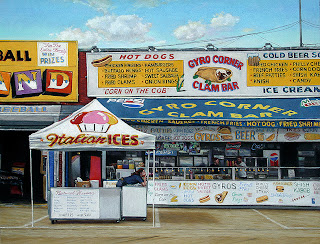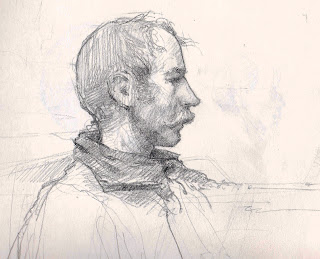
I think when the term "realism" is applied to visual art there is a tendency by viewers, critics and artists to neglect the abstract design that an image is structured upon. A good "realist" painting has all the same considerations as an abstract painting, composition, form, color, line, surface quality etc. and has the added complexity of conveying beleivable representation of light, space, form and time. When all the elements of picture making are handled skillfully the viewer may overlook all the thought that goes into composing the image, when the rendering is executed poorly it's evident to even the untrained art viewer.
It's a difficult business.
Essentially we are taking a two dimentional surface and are transforming it to convey such a complicated range of elements. Depth, perspective, structure, form, color, light, shadow, hard and soft edges, texture, time of day, personality, mood, a sense of time and place, maybe a narrative. Mix in with that the added response that the person viewing a painting brings to the image, their own memories and experiences and you have a great number of things to consider.
In my painting "Italian Ices" the composition plays a number of square and rectangular shapes off each other, almost like a Mondrian handled through a filter of realist artist. The pop-up shade tent of the Italian Ice stand creates a triangular shape that I echo girl's posture and repeat in array of wires in the upper right. The signage gave me the chance to repeat the use of a number of colors throughout the composition.
I was interested in the posture of the girl working the Italian Ice stand on the boardwalk at Coney Island in Brooklyn, New York. The scene also offered the opportunity to juxtapose the figure against the busy signage of the boardwalk. The couple in the background serves as a secondary focal point and draws the viewers eye and directs it through all the items in the glass counter and behind the counter. Although every item is taken to a high degree of rendering, the objects in the interior space have a more subdued handling of color, placing the figures in that space attracts attention to that area of the painting.
I chose pastel as the medium for this painting, it was challenging to create this picture in pastel but I think the image called for it.
It's a difficult business.
Essentially we are taking a two dimentional surface and are transforming it to convey such a complicated range of elements. Depth, perspective, structure, form, color, light, shadow, hard and soft edges, texture, time of day, personality, mood, a sense of time and place, maybe a narrative. Mix in with that the added response that the person viewing a painting brings to the image, their own memories and experiences and you have a great number of things to consider.
In my painting "Italian Ices" the composition plays a number of square and rectangular shapes off each other, almost like a Mondrian handled through a filter of realist artist. The pop-up shade tent of the Italian Ice stand creates a triangular shape that I echo girl's posture and repeat in array of wires in the upper right. The signage gave me the chance to repeat the use of a number of colors throughout the composition.
I was interested in the posture of the girl working the Italian Ice stand on the boardwalk at Coney Island in Brooklyn, New York. The scene also offered the opportunity to juxtapose the figure against the busy signage of the boardwalk. The couple in the background serves as a secondary focal point and draws the viewers eye and directs it through all the items in the glass counter and behind the counter. Although every item is taken to a high degree of rendering, the objects in the interior space have a more subdued handling of color, placing the figures in that space attracts attention to that area of the painting.
I chose pastel as the medium for this painting, it was challenging to create this picture in pastel but I think the image called for it.




















